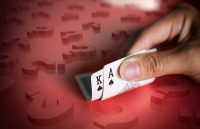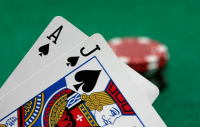Blackjack Betting Strategies
Have you ever thought that you could get an advantage over the house just by altering your bet sizes or what you bet on at the right times? Many betting strategies exist that claim to be able to do just that. They claim that by changing your bets based on recent results, you can gain an edge over the house in a game (like blackjack) that normally has a house edge for the casino.
Are these systems for real? Well, that depends. It might be best to divide betting strategies into two categories, just to separate the effective methods from those that are ineffective (and sometimes sold as scams). Any betting strategy that claims to be able to structure bets that all have a house edge and somehow make you a winner is bound to disappoint you, because it simply isn’t possible to take multiple bets with negative expectations and come out with an overall positive expectation. We’ll call these betting systems. On the other hand, betting strategies that offer you ways to maximize your advantage or limit your risk of going broke when you already have the edge can be an important part of a professional blackjack player’s overall strategy.
Editor’s Picks for Best Online Blackjack in 2024
- Online and mobile blackjack
- Casino, Poker & Sportsbook
- Fast Bitcoin withdrawals
$3,000
- Live Dealer Blackjack
- 24/7 Live Support
- Trusted since 2007
- Highly rated blackjack casino
- Vegas style blackjack
- Welcomes American players
$11,000
- Online and mobile blackjack
- Great for U.S. based players
- New and fresh
Betting Systems
Over the years, many people have tried to come up with betting systems that could beat various casino games. They appeal to a lot of players, especially those who don’t understand the math behind gambling. Often, they make some sort of intuitive sense, which leads people to come up with reasons to believe that their system must work. However, as we said earlier, no betting system can turn a series of bets with a house edge into a system that has an edge for the player.
Martingale System
Let’s take a look at one common betting system and see how it works – and why it doesn’t work.
The Martingale System is probably the best known casino gambling system in the world, and also the most popular. It is incredibly simple to use, and seems to offer a “can’t lose” way of playing games that offer bets that are around 50/50 propositions.
In the Martingale System, the player begins by making a small bet – usually the table minimum. If the player wins, they make that same small bet again. If they lose, they instead double their bet. If the player loses again, they double their bet again. The player continues doubling their bet until they win, at which point they revert to their original small bet size.
This means that in each iteration of the Martingale, the player will win the minimum bet size. For instance, a player might win their original $5 bet, thus profiting $5. Or they might have the following sequence:
Lose $5
Lose $10
Lose $20
Win $40
Meaning they would lose $35 but then win $40, thus coming out $5 ahead yet again.
So, why doesn’t this work? Eventually, you will hit a string of losses that will be catastrophic, wiping out your bankroll and any small profits you’ve made so far. Many players believe a long string of losses like that is unlikely, and they’re right; however, it will happen often enough that the casino retains the house edge they had at the beginning of the game. Table limits make this occur even faster, meaning you’ll quickly hit a point where you simply can’t double your bet anymore.
For instance, take a table with a minimum bet of $5 and a maximum bet of $500. The player can double six times:
$5
$10
$20
$40
$80
$160
$320
After that, the player cannot double to $640. For the moment, let’s do an example with single-zero roulette, since the math is easier. If the player makes a bet on one of the even money bets – say, betting on black – they have 18 ways to win, and 19 ways to lose. This means the player will lose 51.3% of the time. This also means that at any given time, there’s about a 0.94% chance that they’ll run into a 7-spin losing streak, putting them in the position of not being able to double. That’s only one time in 106 (we’re rounding a bit, but that’s roughly accurate), but that’s still not good enough to make the Martingale work! The player will make $525 in the 105 times they win, but they’ll lose $635 the one time they hit a 7-spin losing streak.
The math for blackjack is a bit more complicated, since not all bets pay even money, you’ll sometimes have to spend extra money to double down or split, and the player wins fan less than half of the hands (especially when taking pushes into account). However, the principle remains the same – the player cannot overcome a series of bets that have a house edge simply by creatively structuring their bets.
Betting Strategies and the Kelly Criterion
On the other hand, can betting strategies help you when you already have an advantage? The answer is emphatically yes! In fact, betting strategy is critical for anyone who wants to be a profitable blackjack player. For instance, card counting relies heavily on betting strategy, as the player must bet more when he has the advantage, and less (or not at all) when things swing in the dealer’s favor.
But betting strategy can be much more complex than that. While it’s obvious that players should bet more when they have an edge, it’s harder to figure out how much they should bet on a typical hand. Figuring that out requires the player to take into account the size of their bankroll, as well as the size of their edge over the house.
One method of figuring out the optimal bet size is to use the Kelly Criterion. The Kelly Criterion is an attempt to maximize the rate at which a player can make money when they have an edge without having a significant risk of ruin. The formula is basically as follows:
f = (bp-q)/b
f = the portion of the player’s bankroll they should wager on each bet.
b = the odds the player is receiving on each wager (b to 1).
p = the probability of winning the wager.
q = the probability of losing the wager.
For instance, imagine a game where the player receives even money odds (1-1), but feels as though they have a 55% chance of winning each hand. This would make the formula look like this:
f = (1*.55 – .45)/1
f = .1
In this case, the Kelly Criterion suggests betting .1, or 10% of the player’s bankroll, on each bet in order to maximize the growth-rate of the player’s bankroll. Of course, players rarely have such a huge edge, and blackjack is a bit more complex since the player sometimes wins differing amounts, and sometimes is forced to wager additional money on a hand. We’ll go into more detail on how to use the Kelly Criterion when playing blackjack in our article on Bankroll Management.















